Discover 10 stunning bell-shaped flowers that will add elegance and charm to your garden. Learn about their unique features and care tips.
Are you looking to add some elegance and charm to your garden? Bell-shaped flowers might be just what you need. These lovely blooms dangle gracefully from their stems, creating a whimsical and enchanting atmosphere. In this article, we’ll explore 10 stunning bell-shaped flowers that will make your garden stand out. We’ll also share some care tips to help these beauties thrive.
1. Foxglove
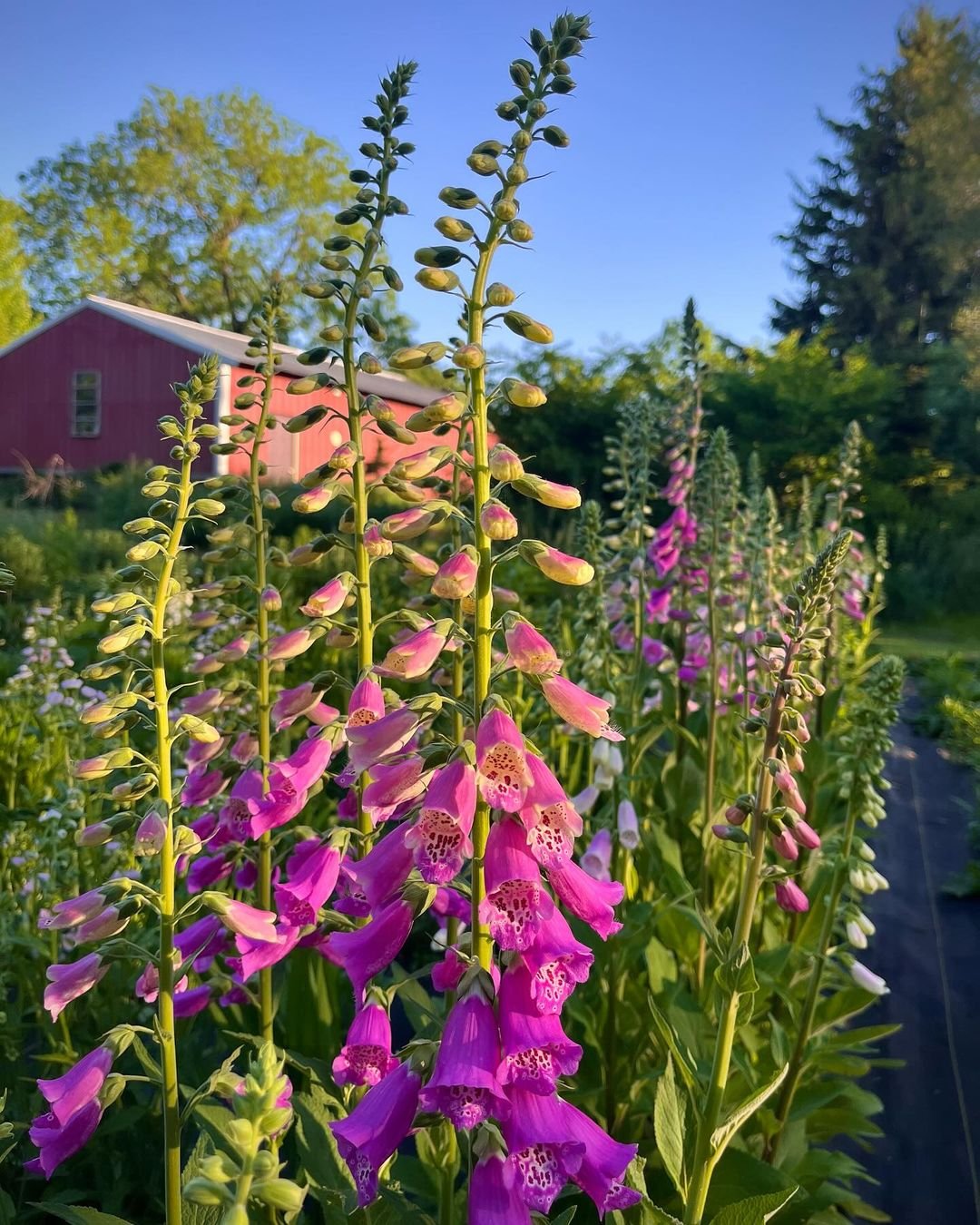
Here’s a short information chart about Foxglove (Digitalis):
| Aspect | Information |
|---|---|
| Botanical Name | Digitalis |
| Common Name | Foxglove |
| Appearance | Tall spikes with tubular flowers |
| Leaf Shape | Lanceolate, arranged in a rosette |
| Plant Type | Biennial or short-lived perennial |
| Zones | Typically zones 4-8, depending on species |
| Sun Exposure | Part shade to full sun |
| Soil Type | Moist, well-draining |
| Watering | Regular; keep soil evenly moist |
| Fertilization | Generally not required; may benefit from balanced fertilizer before flowering |
| Growth Habit | Upright, clumping |
| Height/Spread | 2-5 feet tall, 1-2 feet wide |
| Pests | Susceptible to aphids, slugs and snails |
| Special Features | Attractive to bees and hummingbirds; poisonous if ingested |
Foxgloves are tall, striking plants with bell-shaped flowers that grow in clusters along their stems. These flowers come in shades of pink, purple, white and yellow. Foxgloves are perfect for adding vertical interest to your garden.
Care tips:
- Plant foxgloves in partial shade
- They prefer well-draining soil
- Water regularly, especially during dry spells
Fun fact: Foxgloves are biennial plants, meaning they typically bloom in their second year of growth.
2. Lily of the Valley
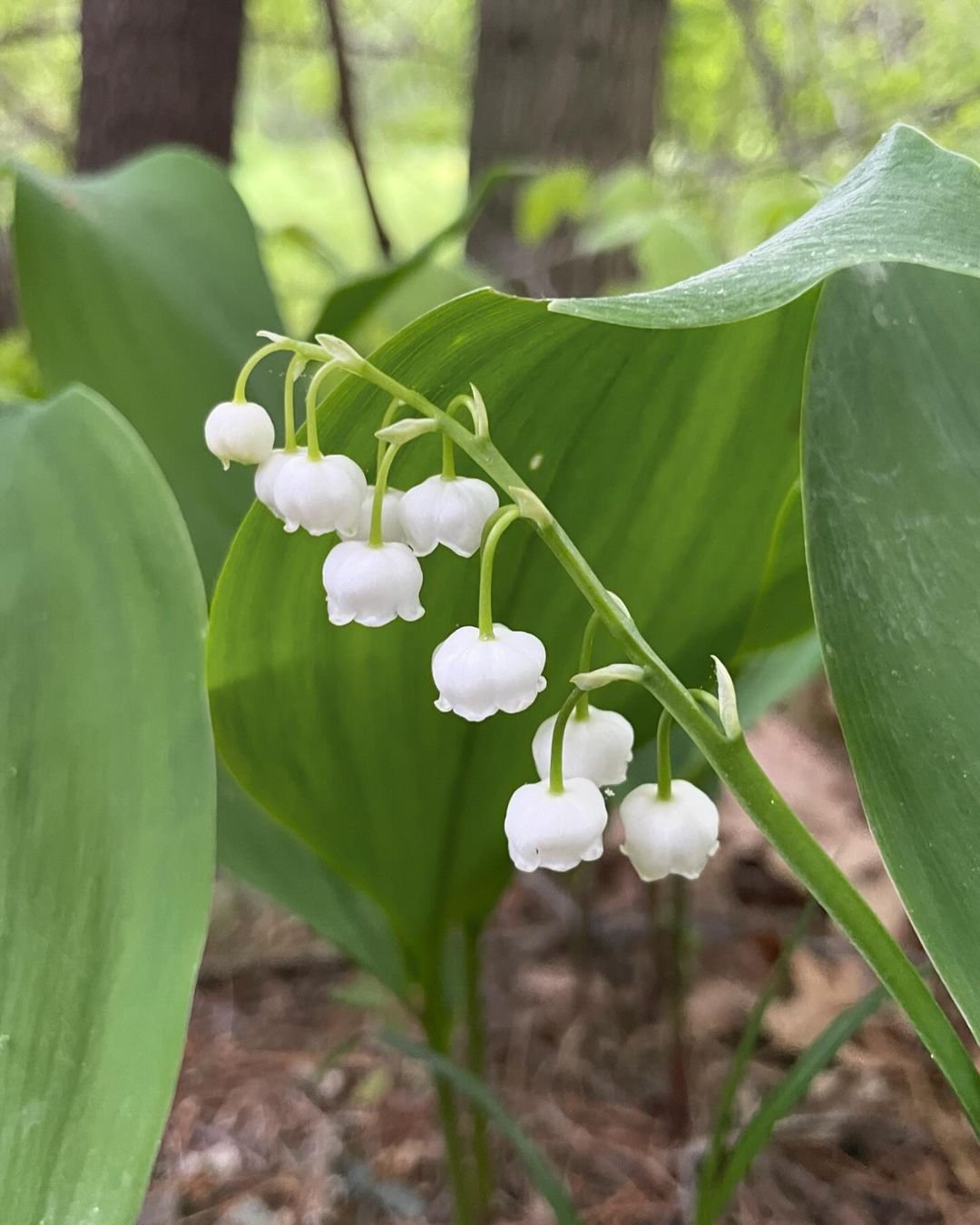
Here’s a short information chart about Lily of the Valley (Convallaria majalis):
| Aspect | Information |
|---|---|
| Botanical Name | Convallaria majalis |
| Common Name | Lily of the Valley |
| Appearance | Clusters of small, bell-shaped white flowers |
| Leaf Shape | Oval-shaped, glossy green |
| Plant Type | Perennial |
| Zones | Typically zones 3-8 |
| Sun Exposure | Shade to part shade |
| Soil Type | Moist, well-draining |
| Watering | Regular; keep soil evenly moist |
| Fertilization | Light feeding in spring with a balanced fertilizer |
| Growth Habit | Spreading, ground-covering |
| Height/Spread | 6-10 inches tall, spreads slowly via rhizomes |
| Pests | Generally pest-free |
| Special Features | Fragrant flowers; spreads via underground rhizomes |
These delicate, white bell-shaped flowers have a sweet fragrance that will fill your garden with a lovely scent. Lily of the Valley blooms in spring and is perfect for shady areas.
Care tips:
- Plant in full to partial shade
- Keep the soil consistently moist
- Divide clumps every 3-4 years to prevent overcrowding
Caution: All parts of Lily of the Valley are toxic if ingested, so be careful if you have pets or small children.
3. Bluebells
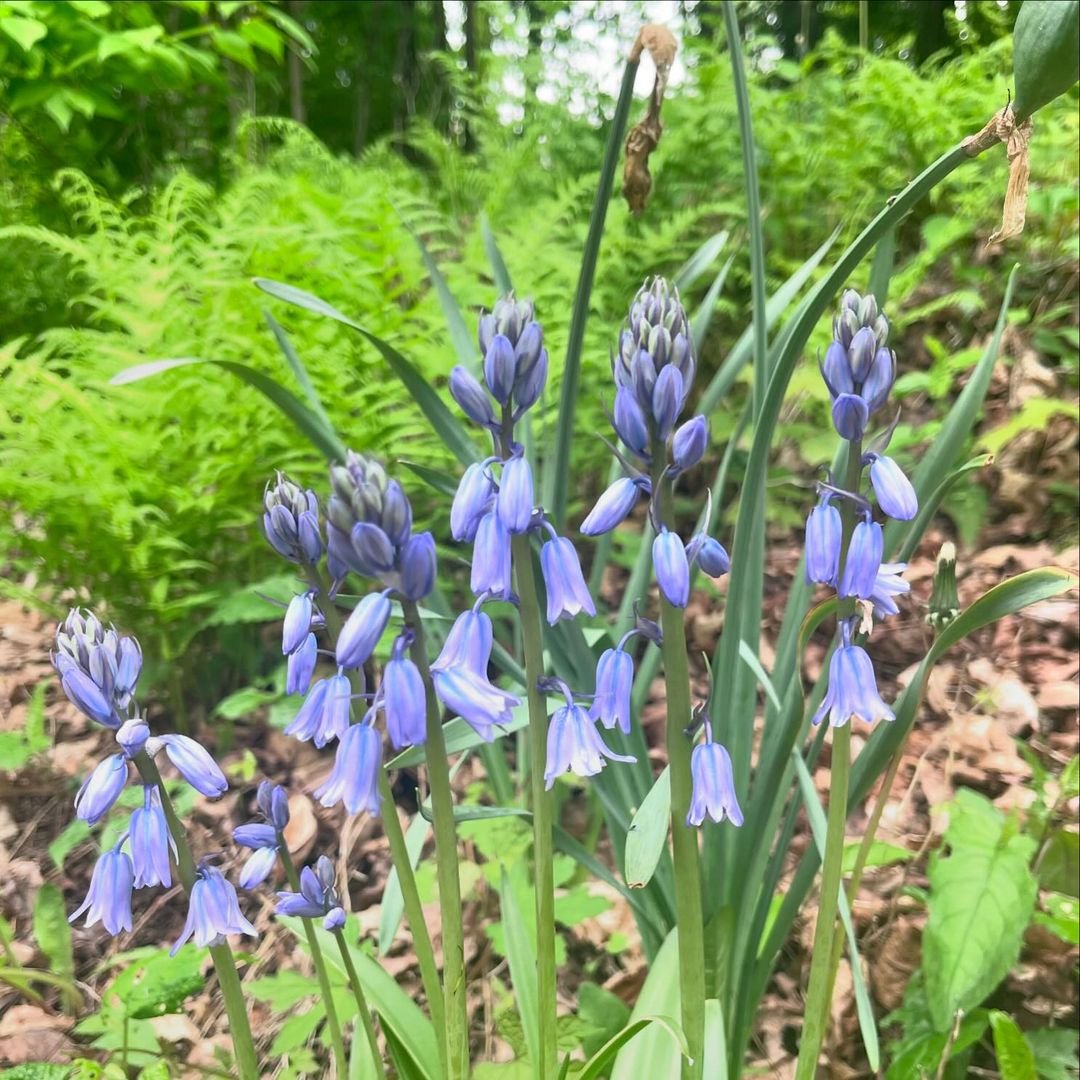
ere’s a short information chart about Bluebells (Hyacinthoides non-scripta):
| Aspect | Information |
|---|---|
| Botanical Name | Hyacinthoides non-scripta |
| Common Name | Bluebell |
| Appearance | Clusters of bell-shaped flowers, usually blue-purple |
| Leaf Shape | Narrow, strap-like |
| Plant Type | Perennial bulb |
| Zones | Typically zones 4-8 |
| Sun Exposure | Part shade to full shade |
| Soil Type | Moist, well-draining |
| Watering | Regular; prefers moist soil |
| Fertilization | Light feeding with a balanced fertilizer in spring |
| Growth Habit | Clumping, spreads slowly via bulbs |
| Height/Spread | 12-18 inches tall, spreads gradually |
| Pests | Generally pest-free |
| Special Features | Fragrant flowers; naturalizes in woodland settings |
These charming flowers create a carpet of blue in woodlands during spring. English bluebells have a distinctive curved stem with flowers hanging on one side.
Care tips:
- Plant in partial shade or dappled sunlight
- They thrive in moist, well-draining soil
- Allow foliage to die back naturally after blooming
Did you know? Bluebells are protected by law in the UK due to their cultural significance.
4. Bellflower
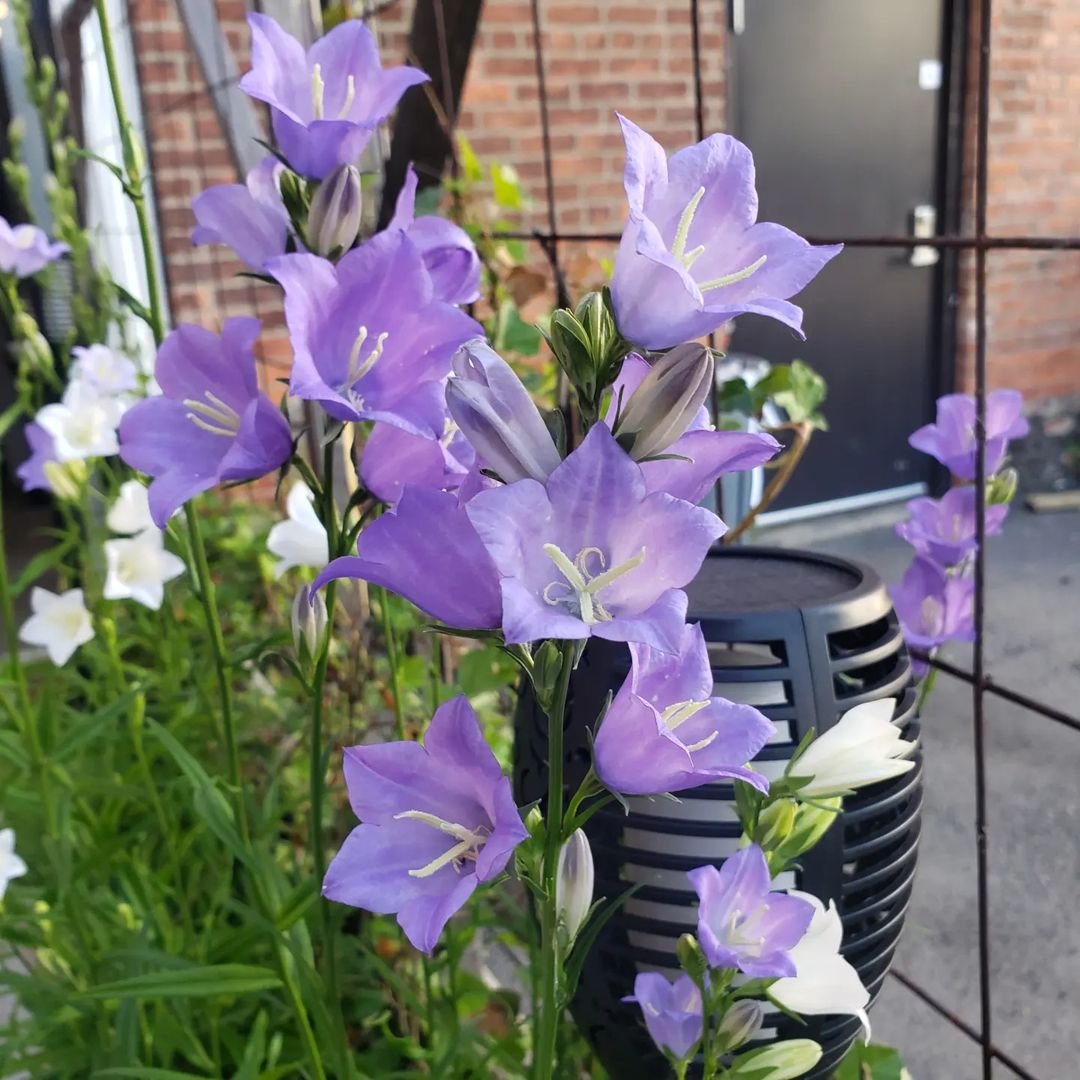
Here’s a short information chart about Bellflower (Campanula):
| Aspect | Information |
|---|---|
| Botanical Name | Campanula |
| Common Name | Bellflower |
| Appearance | Bell-shaped flowers in various colors |
| Leaf Shape | Usually heart-shaped or lanceolate |
| Plant Type | Perennial or biennial |
| Zones | Varies by species; generally zones 3-8 |
| Sun Exposure | Full sun to part shade |
| Soil Type | Well-draining |
| Watering | Regular; moderate water needs |
| Fertilization | Light feeding with balanced fertilizer in spring |
| Growth Habit | Upright, spreading or clumping |
| Height/Spread | Varies by species; typically 6 inches to 3 feet tall |
| Pests | Generally pest-free; may attract slugs and snails |
| Special Features | Attractive to bees and butterflies; various cultivars available |
Campanula, also known as bellflower, comes in various species with different growth habits. Some are low-growing and perfect for rock gardens, while others are tall and ideal for borders.
Care tips:
- Most bellflowers prefer full sun to partial shade
- Plant in well-draining soil
- Deadhead spent blooms to encourage more flowers
Interesting fact: The name “Campanula” comes from the Latin word for “little bell.”
5. Coral Bells
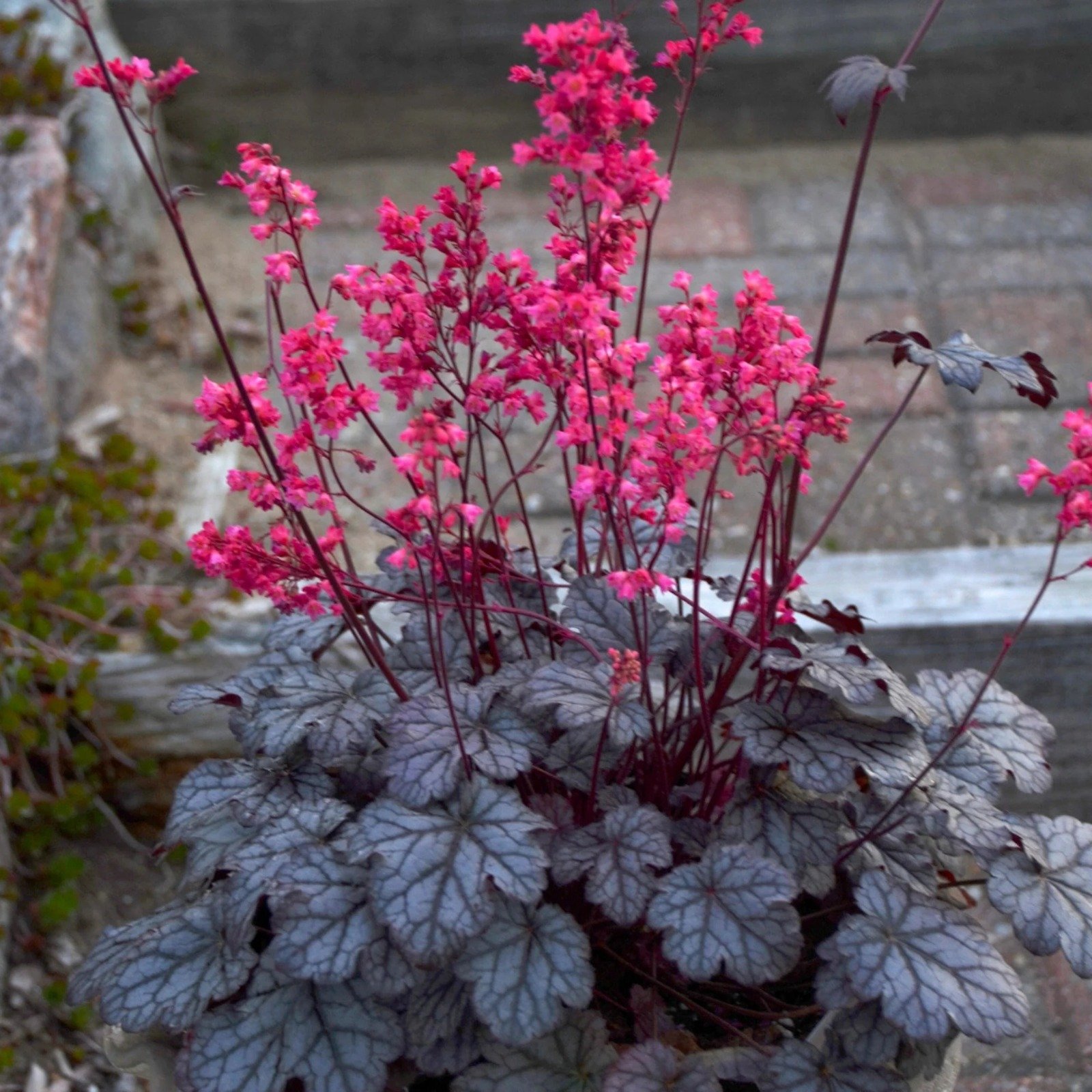
Here’s a short information chart about Coral Bells (Heuchera):
| Aspect | Information |
|---|---|
| Botanical Name | Heuchera |
| Common Name | Coral Bells |
| Appearance | Clusters of small, bell-shaped flowers on slender stalks; often prized for colorful foliage |
| Leaf Shape | Round to heart-shaped, often with ruffled edges |
| Plant Type | Perennial |
| Zones | Typically zones 4-9 |
| Sun Exposure | Part shade to full shade |
| Soil Type | Well-draining, fertile soil |
| Watering | Regular; keep soil evenly moist |
| Fertilization | Light feeding with a balanced fertilizer in spring |
| Growth Habit | Compact, mound-forming |
| Height/Spread | 6-18 inches tall, 12-24 inches wide depending on variety |
| Pests | Generally pest-free |
| Special Features | Colorful foliage in shades of green, purple, or red; attracts hummingbirds |
While known primarily for their colorful foliage, coral bells also produce tiny bell-shaped flowers on tall, slender stems. These flowers attract hummingbirds and butterflies.
Care tips:
- Plant in partial shade
- They prefer well-draining soil
- Water regularly but avoid overwatering
Pro tip: Coral bells make excellent container plants due to their compact size and attractive foliage.
6. Angel’s Trumpet
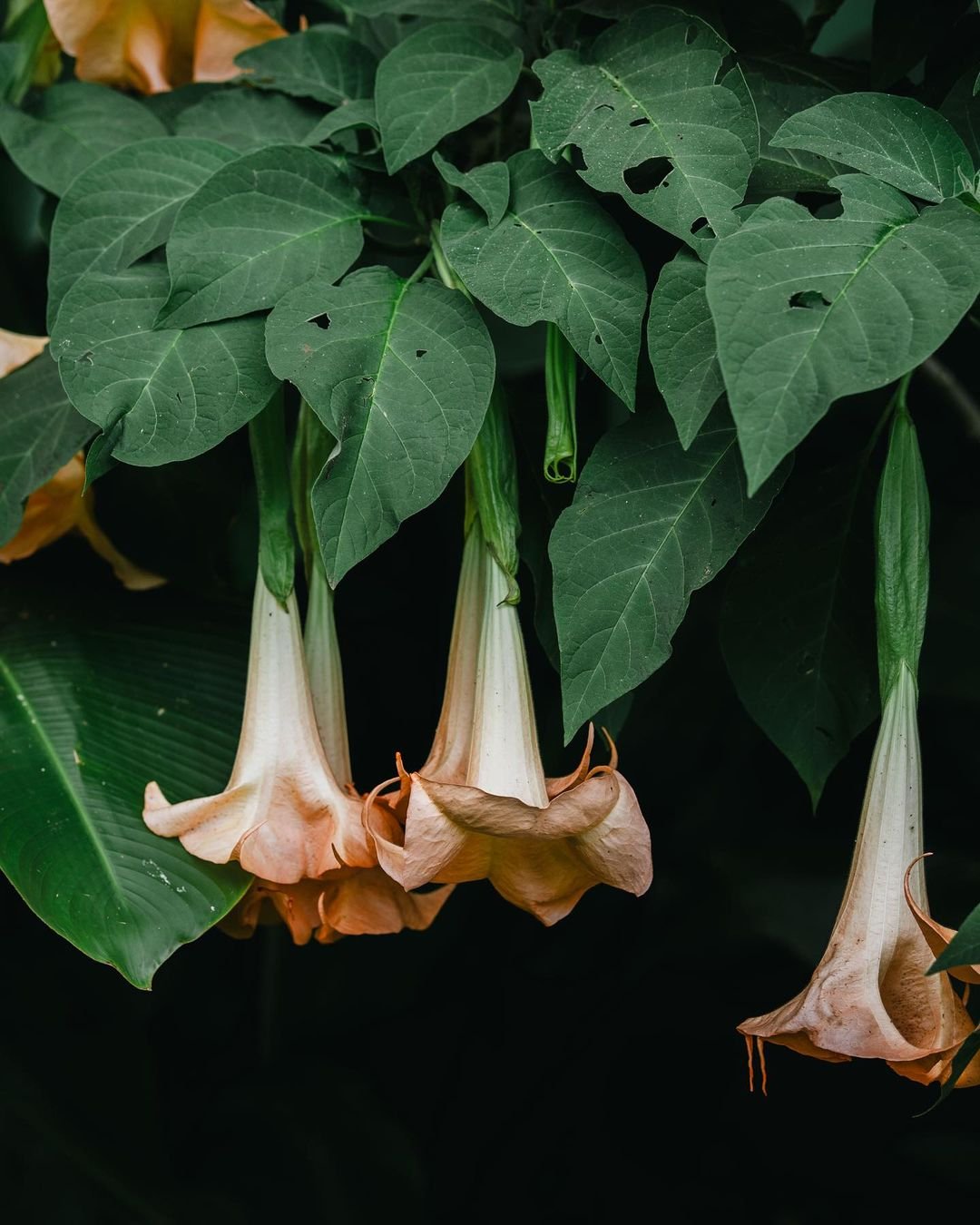
Here’s a short information chart about Angel’s Trumpet (Brugmansia):
| Aspect | Information |
|---|---|
| Botanical Name | Brugmansia |
| Common Name | Angel’s Trumpet |
| Appearance | Large, trumpet-shaped flowers that hang downwards |
| Leaf Shape | Large, oval or lanceolate |
| Plant Type | Woody perennial shrub or small tree |
| Zones | Typically zones 9-11 |
| Sun Exposure | Full sun to part shade |
| Soil Type | Rich, well-draining |
| Watering | Regular; keep soil evenly moist |
| Fertilization | Regular feeding with a balanced fertilizer |
| Growth Habit | Upright, branching |
| Height/Spread | 6-20 feet tall, 3-10 feet wide depending on variety |
| Pests | Susceptible to aphids, spider mites, and whiteflies |
| Special Features | Fragrant flowers; poisonous if ingested; impressive evening fragrance |
These large, tropical plants feature dramatic, pendulous flowers that can reach up to 12 inches in length. Angel’s trumpets come in shades of white, yellow, pink, and orange.
Care tips:
- Plant in full sun to partial shade
- They need rich, well-draining soil
- Water deeply and regularly
Warning: All parts of Angel’s Trumpet are highly toxic. Handle with care and keep away from children and pets.
7. Canterbury Bells
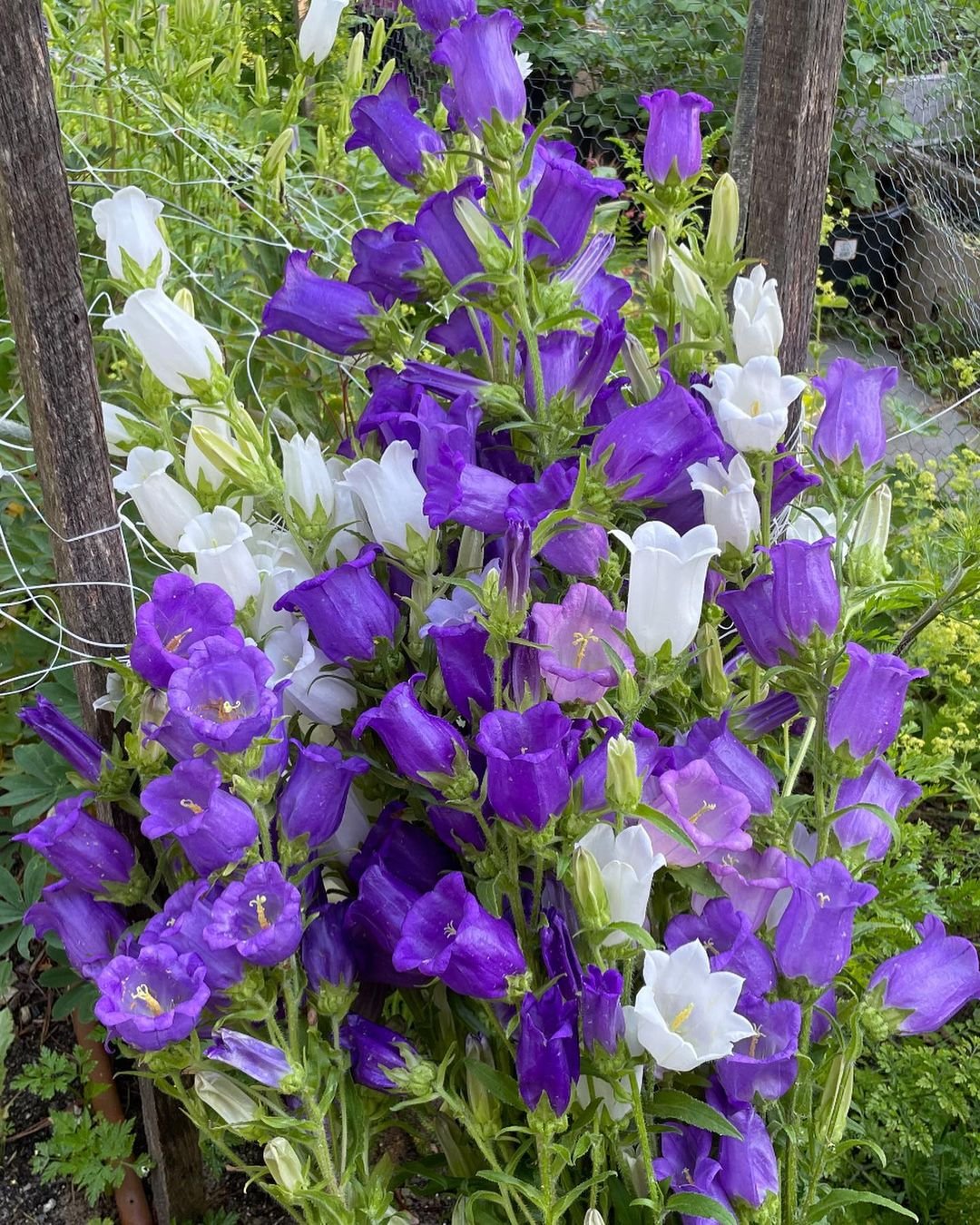
Here’s a short information chart about Canterbury Bells (Campanula medium):
| Aspect | Information |
|---|---|
| Botanical Name | Campanula medium |
| Common Name | Canterbury Bells |
| Appearance | Bell-shaped flowers in shades of blue, pink or white |
| Leaf Shape | Heart-shaped, toothed |
| Plant Type | Biennial |
| Zones | Typically zones 4-8 |
| Sun Exposure | Part shade to full sun |
| Soil Type | Moist, well-draining |
| Watering | Regular; keep soil evenly moist |
| Fertilization | Light feeding with a balanced fertilizer in spring |
| Growth Habit | Upright, branching |
| Height/Spread | 2-3 feet tall, 1 foot wide |
| Pests | Generally pest-free; may attract slugs and snails |
| Special Features | Attractive to bees and butterflies; popular in cottage gardens |
These classic cottage garden flowers produce large, cup-shaped blooms in shades of blue, pink and white. They’re perfect for adding a traditional touch to your garden.
Care tips:
- Plant in full sun to partial shade
- They prefer well-draining soil
- Water regularly during dry spells
Fun fact: Canterbury Bells are biennial plants, like foxgloves.
8. Chinese Lantern
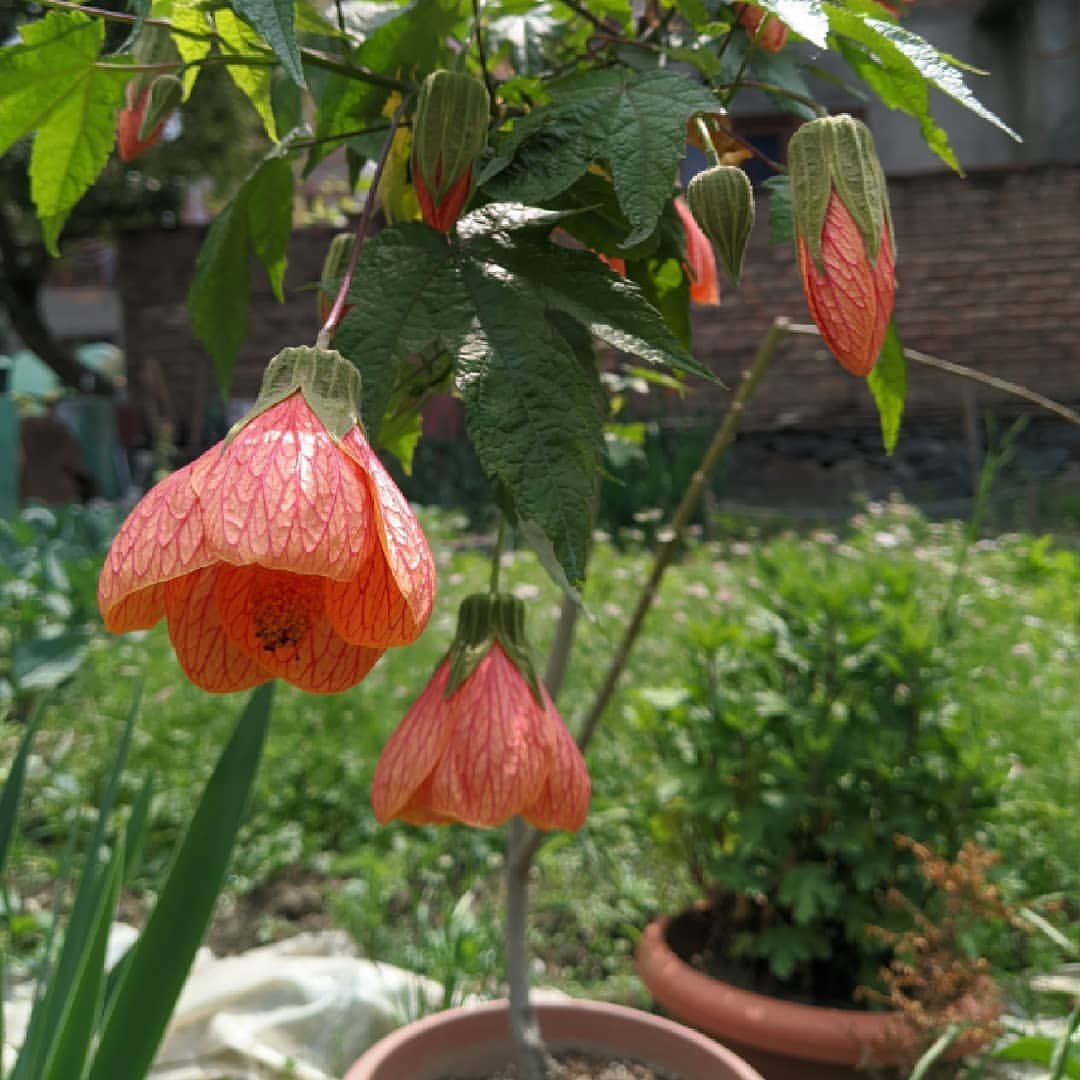
Here’s a short information chart about Chinese Lantern (Abutilon):
| Aspect | Information |
|---|---|
| Botanical Name | Abutilon |
| Common Name | Chinese Lantern |
| Appearance | Bell-shaped flowers resembling lanterns; usually orange or red |
| Leaf Shape | Usually lobed, sometimes heart-shaped |
| Plant Type | Perennial shrub or small tree |
| Zones | Typically zones 8-11 |
| Sun Exposure | Full sun to part shade |
| Soil Type | Well-draining, fertile soil |
| Watering | Regular; keep soil evenly moist |
| Fertilization | Regular feeding with a balanced fertilizer |
| Growth Habit | Upright, bushy |
| Height/Spread | 3-10 feet tall, 3-6 feet wide depending on variety |
| Pests | Generally pest-free; occasionally susceptible to aphids and whiteflies |
| Special Features | Attractive flowers; used in gardens and as houseplants |
Also known as flowering maple, these plants produce charming bell-shaped flowers that hang like little lanterns. They come in various colors, including red, yellow and orange.
Care tips:
- Plant in full sun to partial shade
- They prefer rich, well-draining soil
- Keep soil consistently moist
Did you know? Despite their common name, Chinese Lanterns are not related to maple trees.
9. Snowdrop
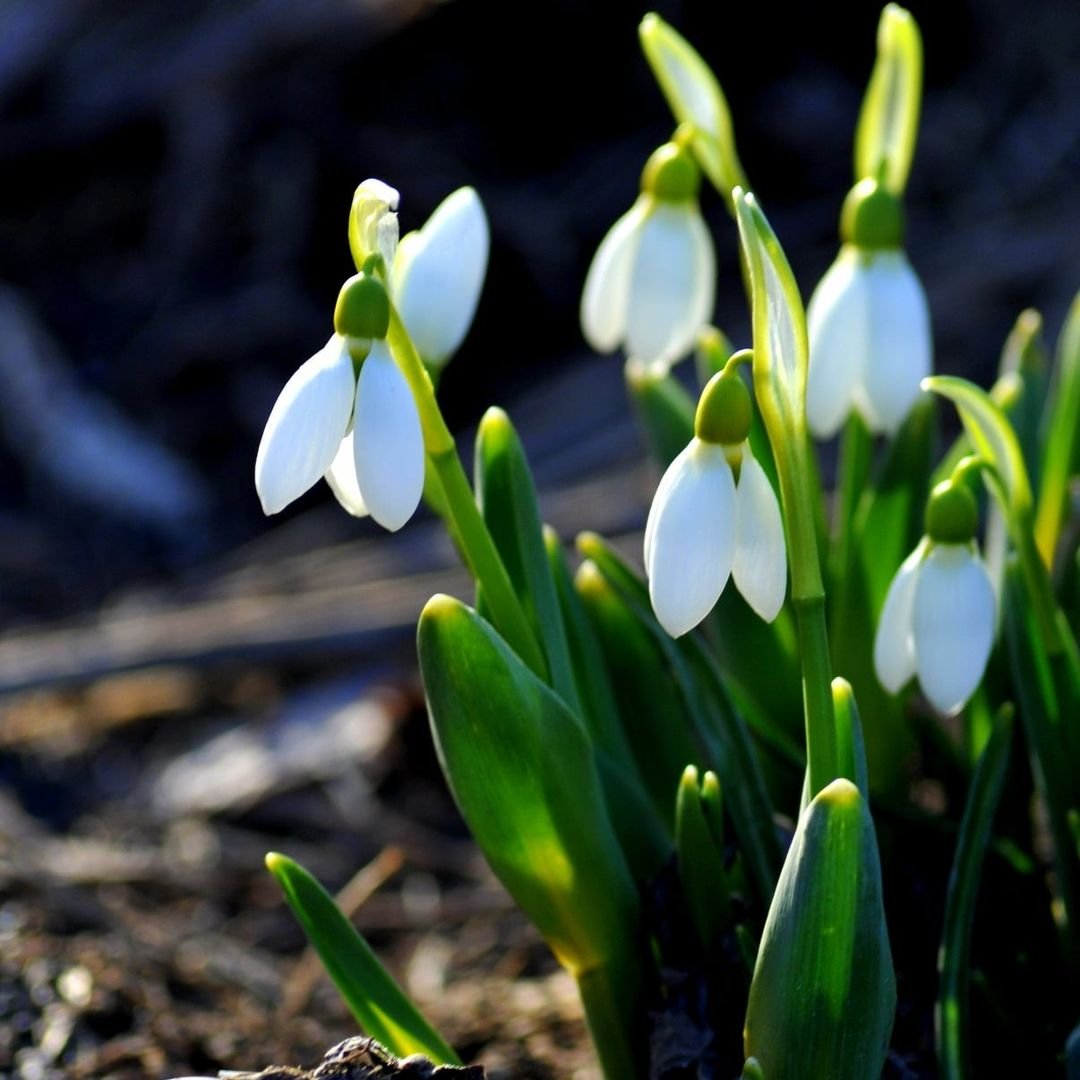
Here’s a short information chart about Snowdrop (Galanthus):
| Aspect | Information |
|---|---|
| Botanical Name | Galanthus |
| Common Name | Snowdrop |
| Appearance | Small, nodding, bell-shaped white flowers with green markings |
| Leaf Shape | Linear, strap-like |
| Plant Type | Bulbous perennial |
| Zones | Typically zones 3-7 |
| Sun Exposure | Part shade to full shade |
| Soil Type | Moist, well-draining |
| Watering | Regular; keep soil evenly moist |
| Fertilization | Light feeding with a balanced fertilizer in early spring |
| Growth Habit | Low-growing, clumping |
| Height/Spread | 4-6 inches tall, spreads slowly via bulbs |
| Pests | Generally pest-free |
| Special Features | Early spring bloomer; naturalizes well in woodland gardens |
These delicate white flowers are often the first to bloom in late winter or early spring. Their nodding, bell-shaped blooms are a welcome sight after a long winter.
Care tips:
- Plant in partial shade
- They prefer moist, well-draining soil
- Allow foliage to die back naturally after blooming
Interesting fact: Snowdrops contain compounds that may be useful in treating Alzheimer’s disease.
10. Fuchsia
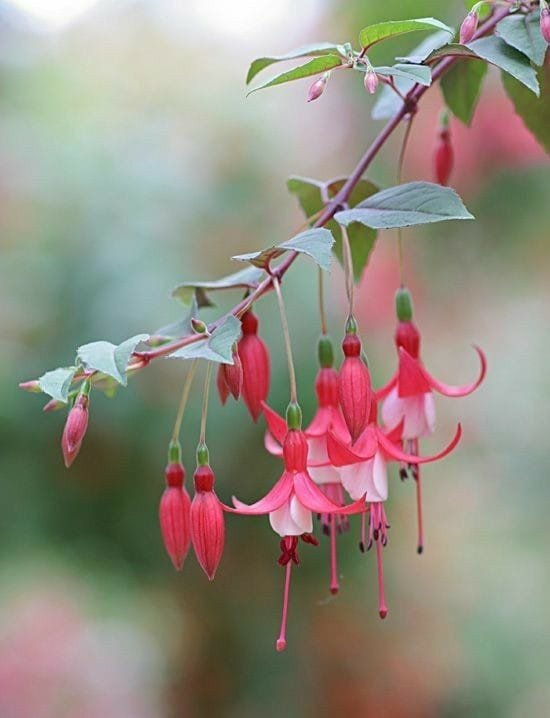
Here’s a short information chart about Fuchsia:
| Aspect | Information |
|---|---|
| Botanical Name | Fuchsia |
| Common Name | Fuchsia |
| Appearance | Bell-shaped flowers in various colors, often bi-colored |
| Leaf Shape | Oval to lanceolate, sometimes serrated |
| Plant Type | Perennial shrub or small tree |
| Zones | Typically zones 8-11 |
| Sun Exposure | Part shade to full shade |
| Soil Type | Rich, well-draining |
| Watering | Regular; keep soil evenly moist |
| Fertilization | Regular feeding with a balanced fertilizer |
| Growth Habit | Upright, bushy |
| Height/Spread | 1-10 feet tall, depending on variety |
| Pests | Susceptible to aphids, whiteflies, and spider mites |
| Special Features | Attractive to hummingbirds; popular in hanging baskets |
These beautiful plants produce stunning, pendant-like flowers in various color combinations. Fuchsias are perfect for hanging baskets or as a colorful addition to shaded areas.
Care tips:
- Plant in partial to full shade
- They prefer rich, well-draining soil
- Keep soil consistently moist
Pro tip: Pinch back growing tips regularly to encourage bushier growth and more flowers.
Caring for Bell-Shaped Flowers
While each type of bell-shaped flower has its specific care requirements, here are some general tips to help your plants thrive:
- Soil preparation: Most bell-shaped flowers prefer well-draining soil. Improve your garden soil by adding organic matter like compost.
- Watering: Many of these plants prefer consistent moisture. Water deeply and regularly, especially during dry spells.
- Fertilizing: Apply a balanced, slow-release fertilizer in spring to promote healthy growth and abundant blooms.
- Pruning: Deadhead spent blooms to encourage more flowers. For perennial varieties, cut back foliage after it dies back naturally.
- Winter care: In colder regions, provide winter protection for less hardy species by mulching around the base of the plants.
- Pest control: Monitor your plants regularly for signs of pests or diseases. Many bell-shaped flowers are relatively pest-resistant, but early detection is key to maintaining plant health.
- Dividing: For perennial species that form clumps, divide them every few years to prevent overcrowding and maintain vigor.
Creating a Bell-Shaped Flower Garden
To create a stunning display of bell-shaped flowers in your garden, consider the following design tips:
- Mix heights: Combine tall species like foxgloves with lower-growing plants like lily of the valley for a layered effect.
- Create color harmony: Choose flowers with complementary or contrasting colors to create visual interest.
- Consider bloom times: Plant a variety of species that bloom at different times to ensure continuous color throughout the growing season.
- Use containers: Many bell-shaped flowers work well in containers, allowing you to move them around for the best display.
- Create woodland gardens: Many bell-shaped flowers naturally grow in woodland settings. Create a shaded area with rich, organic soil to mimic their natural habitat.
- Pair with other plants: Combine bell-shaped flowers with plants that have different flower shapes or interesting foliage for a diverse and appealing garden design.
Bell-shaped flowers offer a unique and charming addition to any garden. From the towering foxgloves to the delicate snowdrops, there’s a bell-shaped flower to suit every gardener’s taste and garden style. By following the care tips provided and getting creative with your garden design, you can create a stunning display that will be the envy of your neighborhood.
Remember, gardening is a journey of discovery and learning. Don’t be afraid to experiment with different combinations of bell-shaped flowers to find what works best in your unique garden environment. Happy gardening!
For more information on flower gardening, check out this comprehensive guide from the University of Illinois Extension.

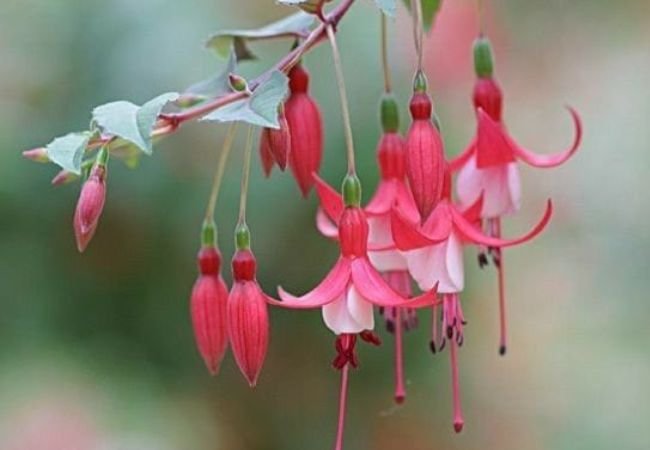





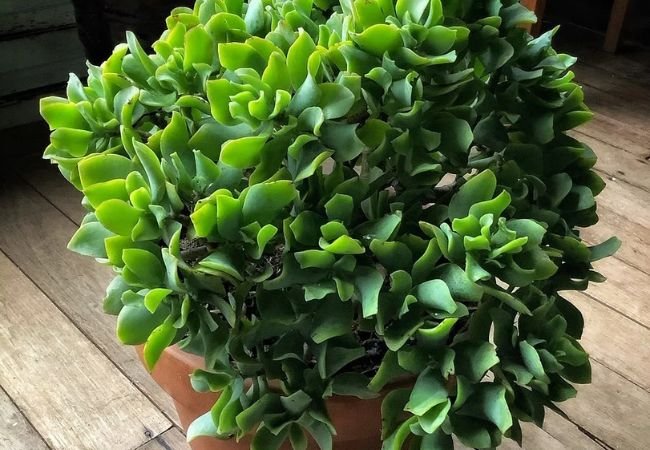
Leave a Reply